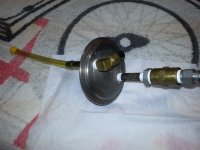Im probably more excited than I should be over this  but it was never on my radar until an Amazon suggestion product pops up under "you might like". Reviews are positive, seems simple enough to operate, price I was thinking every Mityvac was hundreds - was extremely reasonable at under 50 dollars for everything.
but it was never on my radar until an Amazon suggestion product pops up under "you might like". Reviews are positive, seems simple enough to operate, price I was thinking every Mityvac was hundreds - was extremely reasonable at under 50 dollars for everything.
I like to flush the brake fluid every 2 years and the clutch every year. Its around $129 at the dealer for the brake fluid flush and $89 for the clutch fluid flush. The Sonata is coming up on another full system brake bleed and the Forte also needs a correct bleed as I only gravity bled when I replaced the calipers so this Mityvac should do a fine job.
Anyone have tips tricks ect on making this as painless as possible? What is the "correct" sequence when bleeding brakes? I think I would start at the wheel furthest away from master cylinder - then alternate? Both vehicles have ABS, traction/stability control, electronic brake distribution but that's about it.. Its been so many years that I honestly don't remember. I am using Dot 3 synthetic 50K mile like fluid as that's what the cars came with new.
Thanks



I like to flush the brake fluid every 2 years and the clutch every year. Its around $129 at the dealer for the brake fluid flush and $89 for the clutch fluid flush. The Sonata is coming up on another full system brake bleed and the Forte also needs a correct bleed as I only gravity bled when I replaced the calipers so this Mityvac should do a fine job.
Anyone have tips tricks ect on making this as painless as possible? What is the "correct" sequence when bleeding brakes? I think I would start at the wheel furthest away from master cylinder - then alternate? Both vehicles have ABS, traction/stability control, electronic brake distribution but that's about it.. Its been so many years that I honestly don't remember. I am using Dot 3 synthetic 50K mile like fluid as that's what the cars came with new.
Thanks



